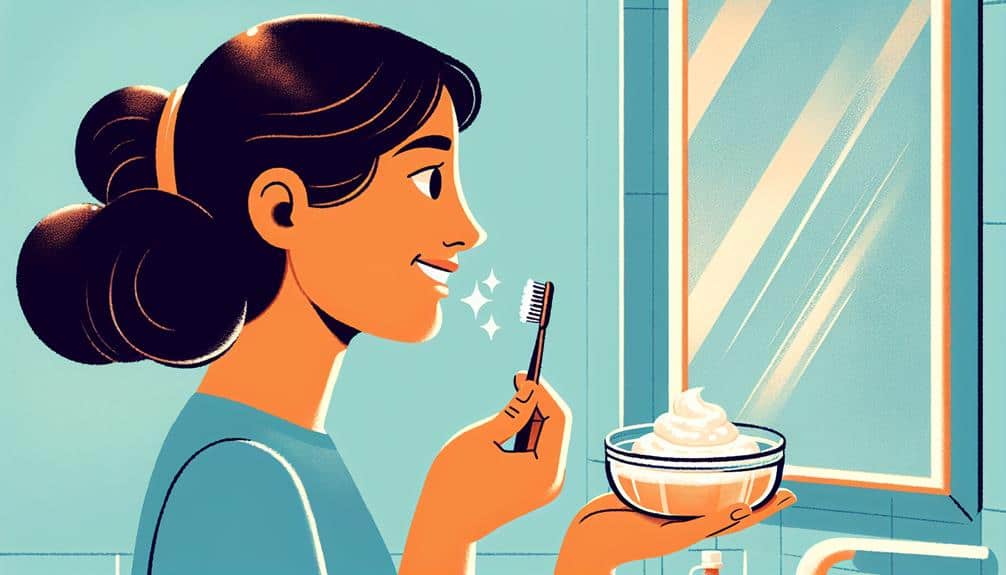Achieve a brighter smile by following these 10 essential steps for an effective teeth whitening procedure. Begin by scheduling a consultation with a dentist to receive professional recommendations and undergo a dental exam and cleaning. Develop a customized whitening plan and gather necessary supplies. Apply the whitening gel properly and consider light or laser activation for best results. Monitor progress, follow post-procedure care, schedule follow-up appointments, and maintain results with regular oral care.HomeAsUpUnlock the secret to a lasting, bright smile by following these essential steps.
Key Points
- Consult a dentist for a personalized whitening plan.
- Apply whitening gel accurately to each tooth.
- Use light or laser activation for effective results.
- Monitor progress with photos and shade guide.
- Maintain results with proper oral care and follow-up appointments.
Consultation With Dentist
Before starting any teeth whitening treatment, it's important to schedule a consultation with your dentist for an evaluation of your oral health and to determine the most suitable whitening approach for you. Your dentist's recommendations are vital as they're based on their professional expertise and knowledge of safe procedures. Dentists can provide valuable insights into the best whitening methods that can deliver proven results while ensuring the safety of your teeth and gums.
During the consultation, your dentist will assess the current condition of your teeth, existing dental work, and any potential issues that may impact the whitening process. This evaluation is crucial to tailor the whitening treatment according to your specific needs and to avoid any complications. Dentists may recommend in-office whitening procedures for faster and more effective results, or at-home treatments that are convenient and easy to use under their supervision.
Dental Exam and Cleaning
Upon completing the consultation with your dentist, the next step in the teeth whitening process involves a thorough dental exam and cleaning. This step is vital in ensuring your oral health is in prime condition before proceeding with any whitening treatments.
Here are some key aspects of the dental exam and cleaning process:
- Comprehensive Examination: Your dentist will perform a detailed assessment of your teeth and gums to identify any underlying issues that may affect the whitening procedure.
- X-rays: X-rays help in detecting any hidden problems such as cavities or infections that need to be addressed before whitening.
- Professional Cleaning: A dental hygienist will perform a thorough cleaning to remove plaque and tartar buildup, which can hinder the whitening process.
- Recommendations for Preventive Care: Based on the exam findings, your dentist may provide recommendations for preventive care to maintain your oral health post-whitening.
Ensuring your teeth are in good health through this examination and cleaning process is essential for a successful and long-lasting whitening outcome.
Customized Whitening Plan
For optimal outcomes, your dentist will develop a personalized whitening plan tailored to your specific needs and goals. This individualized approach guarantees treatment effectiveness and addresses any concerns you may have about teeth sensitivity or existing dental work.
Professional guidance is essential in determining the most suitable whitening products for you. Your dentist will take into account factors such as the current shade of your teeth, the level of whitening desired, and any potential obstacles that may impact the whitening process.
Through a comprehensive assessment, your dentist will recommend the best course of action to achieve your desired results. They'll consider your oral health history and any previous experiences with teeth whitening. By customizing a plan that fits your individual requirements, you can maximize the effectiveness of the treatment and minimize the risk of complications.
Trusting your dentist's expertise in product selection and treatment planning will ensure a safe and successful teeth whitening experience tailored just for you.
Preparation for Whitening
Before starting your teeth whitening process, it's important to gather all the necessary supplies and make sure you have the correct items as per the instructions.
Following the whitening product's usage guidelines precisely can enhance the effectiveness of the treatment and help you achieve desired results.
Preparation is key to a successful whitening experience, so make sure you're well-prepared before beginning the process.
Gather Whitening Supplies
To prepare for whitening your teeth effectively, gather all the necessary supplies in one convenient location. Here are some essential items you'll need for your teeth whitening procedure:
- Teeth Whitening Strips: Considered one of the most popular at-home whitening techniques, these strips are easy to use and offer noticeable benefits.
- Whitening Toothpaste: Using a whitening toothpaste daily can help maintain the results of your whitening treatment.
- LED Teeth Whitening Kit: This modern DIY method combines LED light with whitening gel for enhanced results.
- Activated Charcoal Powder: A natural alternative for whitening, activated charcoal can be used in combination with other products for effective results.
Gathering these supplies beforehand guarantees a smooth and efficient teeth whitening experience.
Follow Usage Instructions
Consider these steps as you prepare for whitening your teeth effectively:
Proper timing is vital when following usage instructions for teeth whitening products. Make sure to adhere strictly to the recommended duration for each session to avoid over-whitening, which can lead to tooth sensitivity or gum irritation.
Additionally, avoiding mistakes such as using more whitening gel than instructed or leaving the product on for longer periods can result in uneven whitening or damage to the enamel.
It's important to carefully read and understand the usage guidelines provided with your chosen whitening product to achieve best results without causing harm to your teeth.
Application of Whitening Gel
For best results in teeth whitening, start by evenly applying the whitening gel onto the surface of each tooth using the provided applicator. When applying the whitening gel, it's important to follow proper techniques to guarantee effective results without causing sensitivity. Here are some essential tips to keep in mind:
- Apply a small amount: Begin by applying a small, pea-sized amount of gel to each tooth to prevent excess product from irritating your gums.
- Use gentle pressure: Apply gentle pressure while spreading the gel evenly across the tooth's surface to ensure consistent coverage.
- Avoid contact with gums: Be cautious not to let the gel come into direct contact with your gums to prevent potential sensitivity or irritation.
- Follow recommended time: Adhere to the suggested application time as specified in the instructions to achieve the desired level of whitening without causing harm.
Activation With Light or Laser
When considering teeth whitening, you may opt for activation with light or laser. Light aids in whitening the teeth, while laser activation offers additional benefits.
This procedure is known for its effectiveness in achieving a brighter smile.
Light for Whitening
To enhance the whitening process, light or laser activation can be utilized for more effective results. When contemplating light therapy benefits, it's crucial to grasp how it can help minimize teeth sensitivity during whitening procedures.
Here are some key points to take into account:
- LED vs. Laser Whitening: LED lights are frequently used for teeth whitening procedures because of their effectiveness and safety. Conversely, laser whitening can offer quicker results but may come with a higher price tag.
- Procedure Duration: LED whitening sessions typically last about 30-60 minutes, making it a convenient option for those with busy schedules.
- Safety Measures: Both LED and laser whitening procedures should be carried out by a trained professional to guarantee safety and excellent results.
- Post-Procedure Care: After the whitening treatment, it's important to follow recommended post-procedure care instructions to uphold the results and prevent sensitivity.
Laser Activation Benefits
Enhance your teeth whitening process by harnessing the benefits of laser activation, ensuring more effective and efficient results. Laser activation offers several advantages for teeth whitening procedures.
The focused light energy accelerates the whitening process, allowing for quicker and more noticeable results compared to traditional methods. Additionally, the controlled nature of laser treatment minimizes the risk of damaging surrounding tissues, ensuring safety during the procedure.
The treatment duration with laser activation is typically shorter, making it a convenient option for individuals with busy schedules. Moreover, the results of teeth whitening with laser activation are often more consistent and longer-lasting, providing you with a brighter and more confident smile.
Experience the benefits of laser activation for a superior teeth whitening experience.
Procedure Effectiveness
Maximize the effectiveness of your teeth whitening procedure by considering the activation method with light or laser, a critical factor in achieving best results. When choosing the activation method, keep in mind the following:
- Whitening Product Recommendations: Select a whitening product that's compatible with the light or laser activation process to guarantee optimal outcomes.
- Potential Side Effects: Be aware of potential side effects such as tooth sensitivity or gum irritation that may be exacerbated by certain activation methods.
- Consultation with a Professional: Seek advice from a dental professional to determine the most suitable activation method based on your oral health and whitening goals.
- Follow-Up Care: Maintain good oral hygiene practices post-treatment to prolong the whitening effects and prevent potential side effects.
Monitoring Whitening Progress
Track your teeth whitening progress by taking regular photos to visually monitor the changes in color. Capturing images before starting the whitening process and throughout can help you measure results effectively.
When taking photos, make sure consistent lighting and focus on capturing the front and sides of your teeth. Comparing these images side by side will allow you to see any improvements in the shade of your teeth.
Additionally, consider using a shade guide to track progress more objectively. A shade guide provides a standardized way to measure the color of your teeth accurately. By comparing your current tooth color to the shades on the guide, you can quantify the changes in color more precisely.
Remember to document the dates when each photo is taken to track the timeline of your progress. Monitoring your teeth whitening journey visually and with a shade guide will help you stay motivated and ensure you achieve the desired results.
Post-Procedure Care Instructions
For best results and to uphold the effects of your teeth whitening procedure, it's essential to follow the post-procedure care instructions diligently.
- Preventing Stains: After your teeth whitening procedure, avoid consuming staining foods and beverages such as coffee, tea, and red wine. If you do consume these, make sure to brush your teeth or rinse your mouth immediately.
- Aftercare Routine: Maintain good oral hygiene practices by brushing your teeth at least twice a day and flossing daily. Use a whitening toothpaste to help preserve your results.
- Avoiding Sensitivity: To prevent sensitivity after teeth whitening, use a toothpaste designed for sensitive teeth. Avoid very hot or cold foods and drinks for the first few days.
- Precautions: Refrain from smoking or using tobacco products as they can quickly stain your teeth. Attend regular dental cleanings to keep your smile bright and healthy.
Follow-Up Appointments
Consider scheduling follow-up appointments with your dentist to monitor the effectiveness of your teeth whitening treatment and address any concerns or touch-ups needed. These post-treatment check-ins are vital for tracking progress updates, evaluating the whitening results, and ensuring long-term maintenance of your enhanced smile.
During these follow-up appointments, your dentist will assess the current shade of your teeth compared to the initial color, discuss any changes in sensitivity or oral health, and recommend further steps to maintain your bright smile. It's imperative to adhere to these appointments to address any issues promptly and optimize the longevity of your whitening treatment.
Moreover, these progress updates allow your dentist to make any necessary adjustments to your treatment plan, such as additional whitening sessions or personalized recommendations for at-home maintenance. By staying proactive with these follow-up appointments, you can guarantee that your teeth remain beautifully white and healthy for the long term.
Maintenance Tips for Longevity
To maintain the longevity of your teeth whitening results, it's essential to establish a consistent oral care routine that incorporates whitening-friendly products and practices. Consistency is key in preserving the long-term results of your teeth whitening procedure. Here are some prevention techniques to help you maintain your bright smile:
- Brush Regularly: Brush your teeth at least twice a day with a whitening toothpaste to remove surface stains and prevent discoloration.
- Floss Daily: Flossing helps to remove plaque and prevent stains from developing between your teeth.
- Avoid Staining Foods and Beverages: Limit your consumption of coffee, tea, red wine, and dark berries that can stain your teeth.
- Regular Dental Check-ups: Visit your dentist for regular cleanings and check-ups to make sure your teeth and gums stay healthy and your whitening results last longer.
Frequently Asked Questions
Are There Any Potential Risks or Side Effects Associated With Teeth Whitening Procedures?
When it comes to teeth whitening procedures, potential risks or side effects may include temporary sensitivity. To manage this, consult your dentist for whitening alternatives or desensitizing products. Prioritize maintaining your oral health.
Can Teeth Whitening Procedures Affect Dental Restorations Such as Fillings or Crowns?
Teeth whitening procedures can impact dental restorations like fillings or crowns due to their non-porous nature. This can affect the longevity of results as restorations won't whiten like natural enamel. Consult your dentist for advice on maintaining a uniform smile.
How Long Does Teeth Whitening Typically Last Before Needing Touch-Ups or a Repeat Procedure?
To maintain your teeth whitening results, consider touch-up frequency. The longevity of whitening typically varies based on lifestyle habits and whitening products used. Follow maintenance tips to prolong results and minimize the need for repeat procedures.
Are There Any Dietary Restrictions or Habits to Avoid After Undergoing a Teeth Whitening Procedure?
After undergoing a teeth whitening procedure, it's essential to maintain your results. Stick to a post-treatment diet free of staining foods like coffee and red wine. Avoid habits like smoking that can undo the whitening effects.
Is It Possible to Over-Whiten Teeth and Damage the Enamel?
You can definitely over-whiten teeth and damage the enamel. Professional guidance is essential to protect your enamel while managing sensitivity. DIY risks can lead to irreversible damage. Trust experts for safe and effective whitening.



